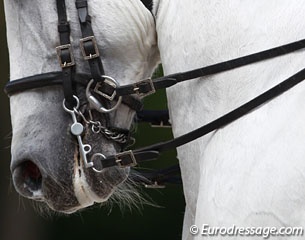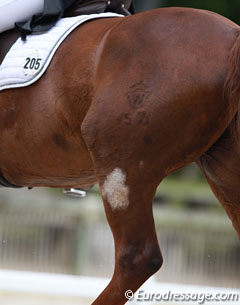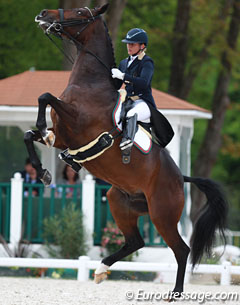
I have often heard riders say that their horse was “working with positive tension” and I wondered whether that was an actual term, or whether that was a nice way of saying “my horse was tense." Is there a distinction between positive and negative tension, or is tension tension? Are there really two sides to the story.
First, I went back and discovered that in the book titled “30 years of training with Master Nuno Oliviera” the glossary defines tension as employed by the master (employed meaning the tension you strive for) as being “semi- tension” or demi tension which in traditional equitation is “where the contact with the snaffle bit is light but permanent; the contact on the curb bit being even more subtle”.
If you think about it, it makes sense. If the horse is just a big blob of jelly than he can’t carry himself, he can’t maintain a connection to the rider, just as if you don’t employ your muscles to hold yourself up you fall over.
I also found there was a distinction made in the book between positive and negative tension (or tautness). “Positive tension or tautness is that of the horse on itself," master Nuno explained. “Whereas bad tension or negative tension is that of a horse against the rider’s hand.”
It makes perfect sense. A horse in self-carriage is carrying himself and using his own muscles to balance into the contact. A horse not in self carriage is against the rider's han and the rider's hand is back against the horse, in a constant battle of negative tension, one pulling against the other.
Hilary Clayton's View on Tension
To go deeper into the topic I spoke with biomechanics expert Hilary Clayton on physical tension, and how this can be broken up into good and bad.
“Physical tension can affect these movement patterns in two ways,” says Hilary. “Either the correct muscles are over-activated which can reduce the range of motion, stiffen the movements or cause a loss of fluency, or extra muscle groups are activated that can change the pattern of movement. When we ask the horse for more physical effort, such as a bigger extension or a sharper angle in the half pass, the muscles must work harder to produce it. Working harder implies greater physical effort and more muscle activity.”
 Hilary noted that greater muscle activity is the same as developing more tension in the muscle, but because the word tension carries some negative connotations she prefers to talk about muscle activity.
Hilary noted that greater muscle activity is the same as developing more tension in the muscle, but because the word tension carries some negative connotations she prefers to talk about muscle activity.
“Therefore, muscular activity (tension) varies according to the demands of the rider and the greater the demands, the more muscle activity (tension) is required. But still the horse is physically relaxed if he performs the exercises with the required amount of muscular activity and without unnecessary muscle activation," she explained.
So how then do we as riders, judges, viewers detect when muscle activity (or tension) has gone beyond the horse's capabilities or is affecting the horse's health? How do we tell if the tension is being employed in a positive or a negative way?
“The terms positive tension and negative tension refer to the muscular activity that is necessary for the horse to perform as required (positive tension) versus the excessive tension that develops when the horse is mentally or physically tense (negative tension),” Hilary stated. “I do sometimes use these terms to help riders to understand the concept of muscle activity being an integral part of performance and that relaxation should not be equated with floppy muscles. However, these are not scientific terms, they are descriptive words used to help people understand and differentiate the necessary and unnecessary muscle activities.”
Tense Horses at Top Level
In reference to the dressage horses we see today, Hilary notes that they are being bred with an exceptional talent for high level competition, but that this sometimes is combined with a highly reactive temperament.
“Breeders face the challenge of producing horses that can perform with this level of athleticism without being mentally over-stimulated. Riders are challenged to be receptive to the mental state of the horse so that the ease and harmony of the performance is maintained.”
 So positive tension is the tension required to perform the job, whereas excess tension is that which bubbles out over the top, and transforms an harmonious pair into two parts battling to stay in control.
So positive tension is the tension required to perform the job, whereas excess tension is that which bubbles out over the top, and transforms an harmonious pair into two parts battling to stay in control.
I wondered then how we as riders can help our horses achieve the muscle activity required for top level dressage without creating excess tension, both physical and mental.
“I do not believe the Grand Prix test is asking too much from the horses," said Hilary, "but the horse has to be adequately prepared technically (able to perform all movements), physically (adequate strength and fitness), and mentally (develop the ability to focus on the rider and ignore distractions that might lead to mental or physical tension). One of the biggest problems today, in my opinion, is that the horses are so athletically talented that the movements come easily. I don’t believe there is a problem in touching on the high level movements in younger horses but they should not be drilled or repeated frequently until the horse has developed the strength that comes only after years of progressive training. Muscular strength is key to producing a peak performance and to maintaining soundness."
In summary, Hilary does not think the requirements of the Grand Prix are excessive and will automatically create negative tension in a horse, but she stressed that horses must be conditioned and strengthened gradually and progressively in order to perform at this level for a prolonged period of time.
by Sarah Warne - Photos © Astrid Appels